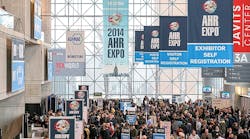For the record, as I write this, Thanksgiving celebrations are just behind us and the house is once again quiet. For the first time in more than a year, we had the whole family under one roof and it was a wonderful time for celebrating, hanging out together, eating, and did I mention eating? I have much personally to be thankful for and I hope that all of you had at least as wonderful a holiday as I did.
But Thanksgiving is often a time of reflection for me and while I was counting my blessings, I also thought about everything that happened in the mechanical systems industry in 2013 and wondered, “How’d we do?”
So let’s look at that. This time last year, the United States was facing “The Fiscal Cliff” and the future of our government’s operation and the economy was shaky, to say the least. Yet the Washington drama closed on a positive note and we were able to steer clear of the cliff and go full steam ahead into 2013.
In January, the AHR Expo in Dallas laid the groundwork for building controls designers to conduct the orchestra in terms of accessing and using newer, more innovative products to help projects meet and exceed expectations, comply with LEED, and really provide the data to help facilities engineers analyze their buildings’ energy use.
Seriously, this technology continues to evolve and change the way the industry works. Who says HVACR isn’t cool?
Speaking of cool, let’s talk about the smart grid for a moment. Much of the wireless communications technology you hear about in the general media is being applied to HVAC products, control systems, and equipment. As the U.S. moves toward upgrading the nation’s energy infrastructure through the use of these products to analyze and control energy use, our country will become less oil dependent and the costs for operating our buildings should come down. We’re talking about smart buildings as part of the smart grid. This is the stuff that makes HVAC building controls are so cool, in my mind.
Plus the smart grid is creating a new industry that should be attractive to young engineers coming out of college—something this industry is in desperate need of. But the tendency, at least among the companies involved in smart grid programs, is to look at electrical contractors and electrical engineers to do this important work.
All I have to say is that when it comes to smart grid careers, don’t forget about the mechanical engineers.
So in 2013, what does all this mean? To me, it all points to the accumulation and analysis of data. Big data is the future of the smart building marketplace and key to the success of the smart grid. Even the clean technologies that are being pushed to the forefront rely on data. Clean technology? We’re talking about renewable-energy technologies that are tied into the federal government’s push for energy and environmental sustainability. Ladies and gentlemen, clean technology is all about the data.
But wait, there’s more: Legislation continues to have an impact on this industry. In particular, the Boiler Maximum Available Control Technology (MACT) standards went into effect this year, sort of. Unfortunately, one of the boiler industry’s strongest voices, Randy Rawson, passed away this year. We’ll miss his insights and leadership.
What’s next? Engineers wondering, "is building certification really necessary" (of course it is)? Who knows. All in all 2013 was an interesting year. I look forward to the challenges and opportunities that are bound to come in the next 12 months.
From the staff of HPAC Engineering, to you and your staffs, families, and friends, have a happy, healthy, and profitable 2014.
Latest from Mike Weil
Latest from Mike Weil
Can HVAC Be Fun? What About All the Eye Candy?
Aug. 7, 2014
HVAC Water Management: Big Changes Ahead
March 31, 2014
Welcome to our new AHR Expo Insider Coverage
Jan. 3, 2014
Related
Related
‘It’s About the Economy, Stupid’
Oct. 2, 2012










